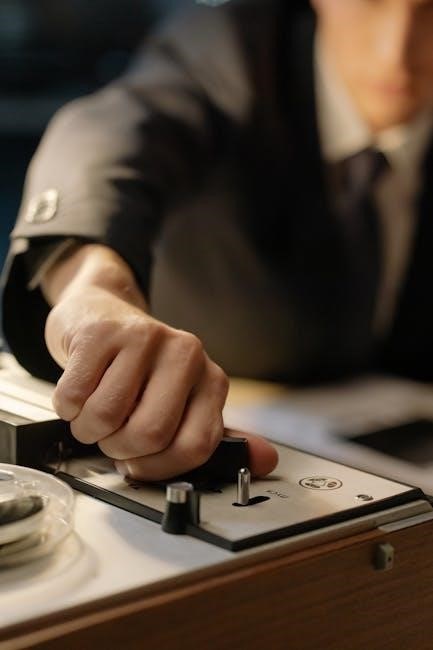
Welcome to the True LAE Controller Manual, your comprehensive guide to understanding and operating the controller effectively. This manual covers installation, operation, and troubleshooting, ensuring optimal performance and safety.
1.1 Overview of the LAE Controller
The LAE Controller is a digital temperature control system designed to regulate refrigeration equipment efficiently. It features an LED display for temperature monitoring and four push-buttons for navigation and operation. The controller supports manual and automatic defrost modes, compressor control, and fan management. It is compatible with True refrigeration systems, ensuring precise temperature maintenance. This overview provides a foundation for understanding its core functions and operational capabilities.
1.2 Importance of the Manual for Proper Operation
This manual is essential for understanding the LAE Controller’s functions, ensuring proper installation, and maintaining optimal performance. It provides detailed instructions for operation, troubleshooting, and customization. By following the guidelines, users can avoid errors, ensure safety, and maximize efficiency. The manual also serves as a reference for advanced features and maintenance, guaranteeing the controller operates at its best and extends equipment lifespan.

Installation and Setup of the LAE Controller
Securely attach the controller to a DIN rail to prevent movement. Connect the power supply and wiring, ensuring compatibility with the specified voltage range. Refer to the manual for detailed wiring diagrams and setup instructions to ensure proper installation and functionality.
2.1 Mounting the Controller
Mount the LAE controller securely on a DIN rail to ensure stability. Insert the controller through a 71×29 mm hole and fasten it properly. Ensure the controller is level and firmly secured to prevent any movement during operation. The display should face upwards for easy access. Refer to the manual for specific mounting instructions and diagrams to guarantee a correct and safe installation.
2.2 Wiring the Controller
Connect the controller according to the wiring diagram, ensuring correct polarity and secure connections. Match the wires to their respective functions, such as power supply, sensor inputs, and output relays. Verify all connections are tight to prevent malfunctions. Refer to the manual for specific wiring instructions and diagrams. Double-check the wiring before powering on the controller to ensure proper operation and safety.
Understanding the LAE Controller Interface
The LAE controller interface features an LED display for temperature monitoring and four buttons for navigation and operation. The display shows real-time data, while buttons control settings and functions.
3.1 LED Display Functions
The LED display on the LAE controller provides real-time temperature readings, alarm notifications, and operational status. It shows measured temperature, setpoints, and defrost modes. The display also indicates alarm conditions, such as high or low temperature alerts, ensuring immediate attention to system issues. Additionally, it provides visual feedback during menu navigation and parameter adjustments, making it essential for monitoring and controlling the system effectively.
3.2 Button Layout and Operations
The LAE controller features four push-buttons, numbered 1-4 from left to right, enabling intuitive navigation and operation. Button 1 typically serves as the Info/Set Point button, while Button 4 often functions as the Manual Defrost/Down button. These buttons allow users to navigate through menus, adjust setpoints, and activate specific functions like manual defrost. The buttons provide tactile feedback, and their operations are visually confirmed on the LED display, ensuring precise control over system settings and functions.
3.3 Navigating the Controller Menu
Navigating the LAE controller menu is straightforward using the four push-buttons. Button 1 typically allows scrolling through menu options, while Button 4 adjusts parameter values. Pressing and holding buttons can access advanced features, such as manual defrost or parameter modification. The LED display provides visual feedback, guiding users through selections and confirming actions. This intuitive interface ensures easy access to all functions, making operation efficient and user-friendly for both basic and advanced tasks.

Defrosting Operations
Defrosting operations ensure efficient removal of ice buildup, maintaining optimal performance. Manual defrost can be activated by pressing and holding the defrost button for 2 seconds, while automatic settings provide scheduled cycles. Synchronization across multiple controllers ensures uniform defrosting, enhancing system efficiency and consistency.
4.1 Manual Defrost Activation
Manual defrost activation allows immediate initiation of the defrost cycle. Press and hold the manual defrost button for 2 seconds until the LED display confirms activation. The controller will then override its schedule, stopping the compressor and activating the defrost heater. This feature is useful for maintaining optimal performance during periods of high humidity or excessive ice buildup. Ensure proper safety precautions are followed during manual defrost operations.
4.2 Automatic Defrost Settings
The automatic defrost feature ensures efficient operation by scheduling defrost cycles based on predefined parameters. Configure defrost intervals and duration through the controller menu to maintain optimal performance. The system automatically initiates defrost during off-peak times, preventing excessive ice buildup. Adjust settings like defrost interval (e.g., every 6-24 hours) and duration (10-60 minutes) to suit your application needs, ensuring energy efficiency and consistent temperature control.
4.3 Defrost Synchronization Across Multiple Controllers
Defrost synchronization enables multiple controllers to operate in unison, ensuring uniform defrost cycles across connected units. When one controller initiates defrost, all linked controllers follow, maintaining consistency. This feature is particularly useful for large systems with multiple evaporators. Adjust synchronization parameters (e.g., DSY) to coordinate defrost timing and duration, optimizing system efficiency and reducing downtime. Remote synchronization can also be triggered via external signals for enhanced control.
Alarm Systems and Notifications
The True LAE Controller features a robust alarm system that alerts users to critical conditions, ensuring timely interventions. Alarms notify of temperature deviations, system malfunctions, and safety breaches, promoting reliable operation and minimizing downtime.
5.1 Types of Alarms and Their Meanings
The True LAE Controller features multiple alarm types, each indicating specific system conditions. High and low temperature alarms alert users to deviations from setpoints, while system fault alarms signal issues like sensor malfunctions or communication errors. Defrost alarms notify when defrost cycles are interrupted or malfunctioning. These alarms ensure timely interventions, preventing equipment damage and maintaining optimal performance. Understanding their meanings enables users to address issues promptly, ensuring safety and efficiency.
5.2 Disabling and Resetting Alarms
To disable an alarm, press and hold the designated button until the alarm clears from the display. Resetting alarms involves addressing the root cause, such as correcting temperature deviations or resolving system faults. Once issues are fixed, alarms automatically reset, restoring normal operation. Ensure all parameters are within acceptable ranges before confirming the reset to prevent recurring alerts.
Parameter Configuration
Parameter configuration allows customization of settings like temperature, defrost cycles, and compressor operation. Adjustments ensure optimal performance tailored to specific applications, maintaining efficiency and reliability.
6.1 Accessing and Modifying Parameters
To access and modify parameters, navigate through the controller menu using the arrow buttons. Select the desired parameter, adjust its value using the numeric keypad or button controls, and save changes. Ensure all modifications align with application requirements for optimal system performance. Refer to the manual for specific parameter codes and adjustment guidelines to avoid errors during configuration.
6.2 Temperature and Defrost Parameters
Temperature parameters allow setting ideal ranges for refrigeration, ensuring precise control. Defrost parameters configure manual or automatic modes, with options for timing and synchronization. Adjust these settings to optimize performance, prevent overheating, or excessive cooling. Refer to the manual for specific codes and guidelines to customize defrost cycles and temperature thresholds effectively, ensuring system efficiency and reliability in various operating conditions.
6.3 Compressor and Fan Settings
Compressor settings regulate operation cycles, including delay timers to prevent short cycling. Fan settings control speed and operation duration, ensuring consistent air circulation. Adjust these parameters to optimize energy use and maintain desired temperatures. Synchronization options allow fans to run with compressors or independently, enhancing system efficiency. Refer to the manual for specific parameter codes and adjustment guidelines to customize compressor and fan behaviors for optimal performance and longevity.

Locking and Unlocking the Controller
Locking prevents unauthorized changes to settings, maintaining consistent operation. Press and hold the Info/Set Point button to lock or unlock, with “YES” indicating locked status and “NO” for unlocked.
7.1 Why Lock the Controller?
Locking the controller prevents unauthorized changes to programmed settings, ensuring consistent operation and protecting against accidental modifications. This feature is crucial for maintaining precise temperature control and operational safety. By locking, you safeguard the controller from tampering, ensuring reliability in commercial environments. The display will show “YES” when locked and “NO” when unlocked, providing clear visual confirmation of the controller’s status.
7.2 Steps to Lock/Unlock the Controller
To lock the controller, press and hold the Info/Set Point button until “YES” appears on the display. Release the button and wait 5 seconds for the display to revert to temperature. To unlock, repeat the process; “NO” will indicate the controller is unlocked. This ensures secure parameter settings and prevents unintended changes, maintaining consistent operation and safety in commercial refrigeration environments.

Troubleshooting Common Issues
Identify and resolve display malfunctions, defrosting problems, and compressor faults by checking connections, parameters, and alarm conditions. Refer to the manual for detailed diagnostic procedures.
Ensure proper wiring and settings to maintain optimal performance and address issues promptly.
8.1 Identifying and Solving Display Issues
Check for blank or incorrect displays by verifying power supply and button functionality. Ensure the controller is unlocked, as locking may restrict display interactions. If the display freezes, restart the controller or reset parameters to default settings. Refer to the manual for detailed diagnostic steps to address any persistent issues effectively.
8.2 Resolving Defrost and Compressor Problems
For defrost issues, ensure manual activation is enabled or check automatic settings. Verify parameter configurations like DTY for correct defrost timing. If compressors fail to start, inspect wiring and power supply. Synchronize defrost operations across multiple controllers to maintain consistency. Consult the manual for detailed diagnostic steps to resolve these issues efficiently and restore optimal system performance. Regular maintenance can prevent such problems.
Advanced Features of the LAE Controller
Explore advanced features like remote control and synchronization, enabling seamless multi-controller operation. Auxiliary outputs enhance system expandability, while defrost synchronization ensures coordinated performance across connected units.
9.1 Remote Control and Synchronization
Remote control enables seamless operation of the LAE controller, allowing users to activate functions like defrost from a distance. Synchronization ensures multiple controllers operate in unison, with the first initiating defrost across all units. This feature enhances efficiency and coordination, eliminating manual intervention. Remote control is activated via specific button presses or external contacts, while synchronization is managed through parameter settings. The LED display confirms remote activation with a “YES” indicator, ensuring proper functionality.
9.2 Auxiliary Outputs and Their Functions
Auxiliary outputs provide advanced control capabilities, enabling management of external devices like compressors, fans, and heaters. These outputs are programmed via specific parameters to perform tasks such as controlling secondary evaporators or activating alarms. For example, 2CU manages auxiliary compressors, while 2EU controls electrical defrost for additional evaporators. Auxiliary outputs enhance system flexibility, ensuring precise control and monitoring of external components, tailored to specific operational needs.

Maintenance and Best Practices
Regularly clean the controller and ensure proper wiring. Follow safety guidelines and update firmware as needed. Schedule routine inspections and refer to the manual for optimal performance.
10.1 Regular Maintenance Tasks
Regular maintenance ensures optimal performance of the LAE controller. Clean the display and buttons periodically to prevent dust buildup. Inspect wiring connections for integrity and tighten if necessary. Check firmware for updates and install them as needed. Verify sensor accuracy and replace batteries in wireless devices. Schedule annual inspections of compressors and fans to ensure proper operation. Refer to the manual for detailed maintenance schedules and procedures.
10.2 Safety Precautions During Maintenance
Always disconnect power before performing maintenance to avoid electrical hazards. Use insulated tools and ensure the system is grounded. Avoid exposing components to water or moisture. Wear protective gear, including gloves and safety glasses. Never bypass safety features or alarms. Handle electronic components with care to prevent damage. Follow all safety guidelines outlined in the manual to ensure personal and equipment safety during maintenance procedures.

Upgrading and Updating the Controller
This section guides you through the process of upgrading and updating your True LAE Controller. Learn how to perform firmware updates and hardware upgrades to ensure optimal performance and security.
11.1 Firmware Updates
Firmware updates enhance your True LAE Controller’s performance and security. Use the info button to check for updates. Ensure a stable power supply before proceeding. Download the latest firmware from official sources. Follow on-screen instructions to complete the update. Regular updates ensure compatibility, improve functionality, and fix potential issues. Always verify the source of the firmware to avoid unauthorized software. Updates are crucial for maintaining optimal controller operation and reliability.
11.2 Hardware Upgrades
Hardware upgrades may be required to enhance functionality or replace outdated components. Always power down the controller before starting. Disconnect wiring and remove the old hardware. Install the new component as per the manual’s instructions. Reconnect wiring carefully to avoid damage. Ensure compatibility with existing systems. After installation, test the controller to confirm proper operation. Upgrades should be performed by qualified personnel to maintain system integrity and performance. Refer to the manual for specific upgrade procedures.

Compliance and Certification
The True LAE Controller complies with safety and environmental standards, ensuring reliable and eco-friendly operation. It meets all relevant regulations, including RoHS and CE certification requirements.
12.1 Safety Certifications
The True LAE Controller is certified to meet rigorous safety standards, including CE, ETL, and UL approvals. These certifications ensure the controller operates safely and reliably in various environments. Compliance with RoHS directives guarantees the absence of hazardous materials, aligning with global environmental and safety regulations. Regular testing and adherence to these standards make the controller a trusted choice for commercial refrigeration systems, ensuring user safety and optimal performance.
12.2 Environmental Compliance
The True LAE Controller adheres to strict environmental regulations, including RoHS compliance, ensuring the absence of hazardous substances. Designed for energy efficiency, it aligns with global sustainability standards, reducing environmental impact. Its eco-friendly design promotes responsible manufacturing and waste reduction, making it a sustainable solution for modern refrigeration systems while maintaining high performance and reliability.

Technical Specifications
The True LAE Controller operates on a 12Vac/dc10 power supply with a 2W rating. It features a 0-100 display range and supports various output types, including relay contacts and auxiliary controls, ensuring compatibility with multiple refrigeration systems.
13.1 Power Supply Requirements
The True LAE Controller requires a stable 12Vac/dc10 power supply with a minimum capacity of 2W. It is designed to operate efficiently across this range, ensuring reliable performance. The controller’s power supply supports its advanced features, including the LED display and output controls. Proper power supply is critical for maintaining accurate temperature regulation and system compatibility. Always use a power source within the specified voltage range to avoid malfunctions and ensure optimal functionality.
13.2 Compatibility with Other Systems
The True LAE Controller is designed to work seamlessly with various refrigeration systems, including Dixell and Danfoss controls. It supports communication protocols for synchronized operations and can integrate with external devices like heaters and fans. Compatibility ensures efficient system performance and adaptability to different refrigeration setups. Always verify specifications for proper integration with your equipment to achieve optimal functionality and reliability.

Downloading the True LAE Controller Manual
The True LAE Controller Manual is available for download from official sources, ensuring access to detailed instructions for proper installation, operation, and maintenance of your equipment.
14.1 Official Sources for the Manual
The True LAE Controller Manual can be downloaded from True Refrigeration’s official website or authorized distributors. Visit the support or resources section for direct access. Additionally, platforms like All-Guides Database offer comprehensive manuals for various True LAE controller models. Ensure to verify the source’s authenticity to download the correct and updated version of the manual for your specific controller model.
14.2 Tips for Effective Use of the Manual
For effective use of the True LAE Controller Manual, read it thoroughly before installation. Familiarize yourself with safety precautions, operational guidelines, and troubleshooting tips. Refer to the troubleshooting section for common issues and solutions. Keep the manual accessible for future reference and updates. Ensure all parameters are set according to your specific requirements for optimal performance and energy efficiency. Regularly review the manual to stay informed about advanced features and maintenance best practices.
Thank you for selecting the True LAE Controller. This manual has guided you through installation, operation, and maintenance. Proper usage ensures optimal performance and longevity. For further assistance, refer to official resources or contact True Refrigeration support. Happy controlling!
True Refrigeration
15.1 Summary of Key Features and Benefits
The True LAE Controller offers advanced temperature control, efficient defrost management, and customizable parameters. Its user-friendly interface with LED display and button layout ensures easy operation. Features include manual and automatic defrost options, alarm systems for proactive maintenance, and synchronization capabilities for multiple controllers. The controller’s design promotes energy efficiency, reliability, and seamless integration with refrigeration systems, making it a robust solution for commercial and industrial applications.
15.2 Final Thoughts on Optimal Controller Usage
For optimal performance, regularly maintain and update your True LAE Controller. Familiarize yourself with its features, such as defrost modes and alarm systems, to ensure efficient operation. Proper usage extends equipment lifespan and maintains consistent temperatures. Refer to the manual for troubleshooting and configuration tips. By following guidelines, you’ll maximize the controller’s efficiency, ensuring reliable operation and minimizing downtime in your refrigeration setup.